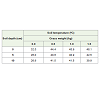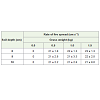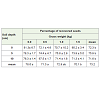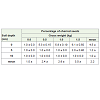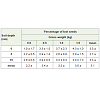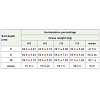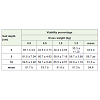Research Article
Effect of Fire on the Viability of Seedsof Acacia seyal Buried in the Soil
Mohamednour Abdelrahim Gasmelseed*
Corresponding author: Mohamednour Abdelrahim Gasmelseed, Department of Forestry, Food and AgricultureOrganization (FAO), Sudan, Saudi Arabia; E-mail: mohamednourg@yahoo.com
Citation: Gasmelseed MA. Effect of Fire on the Viability of Seeds of Acacia seyal Buried in the Soil. J Environ Soc Sci. 2015;2(2): 115.
Copyright © 2015 Gasmelseed MA. This is an open access article distributed under the Creative Commons Attribution License, which permits unrestricted use, distribution, and reproduction in any medium, provided the original work is properly cited.
Journal of Environmental and Social Sciences | Volume: 2, Issue: 2
Submission: 25/07/2015; Accepted: 19/08/2015; Published: 22/08/2015
Abstract
Natural forests of the clay plain of Sudan are continuously decreasing for various reasons including horizontal expansion on cultivation of crops, cutting for fuelwood and grazing. Then, it becomes more important to mobilize the soil seed bank to restore or reforest the vast cleared areas. Therefore, study was carried out to provide some information on the impact of fire burning on the soil seed bank of the dominant tree species in central clay plain of the Sudan, the Acacia seyal, which is frequently devastated by fire.
Seeds of A. seyal with 89% viability were scattered on the soil surface and buried at depths of 5 cm, 10 cm in plots of 1 m². Each plot was mattresses with dry grass biomass of 0.5, 1.0 and 1.5 kg/m² to generate fire of various intensities and residence time. The seeds were dug subsequent to firing to count the recovered ones and test their viability; the lost and charred seeds were also counted.
The percentage of the recovered seeds in the buried plots (71%) was significantly less than those in unburied ones (79%). However, the differences between the plots of various fire intensities were not significant. The germination of all recovered seeds did not exceed 53%, and this percentage decreased as the fire intensity increased. The viability of the recovered seeds decreased from 89% initially to 55% after burning. The percentage of perished seeds was counted as 5% including both the lost (3%) and the charred seeds (2%).
Introduction
Talih (Acacia seyal) is a very important tree species for the versatile uses of its wood, the leaves and flowers as fodder for animals, protects and enriches the soil. It occurs in association with Balanites aegyptiaca in the low rainfall woodland with grass on the clay plains of central Sudan, where the rainfall is from 500 to 800 mm.
The average growing stock in natural forests at the age of 50 to 60years is estimated to 24 m3; haˉ1; and the total above ground volumeabout 33 m³ haˉ1; [1]. Abdel Nour and Satie [2], ElSiddig [3] and Vink[4] mentioned that the stocking volume in natural productive standsrange between 15 to 45 m3; haˉ1; at a felling period of 25 years.
Drought in combination with human activities such as cropping,wood cutting and grazing may affect the vegetation adversely. In Sudan agriculture, particularly shifting cultivation and rainfedmechanizedfarming have been expanded at the expense of natural woodland. Natural forests in the clay plain of Sudan contribute by 76% of the total Sudan energy consumption [5] and this in turn accelerates the rate of deforestation. On the other hand, grazing in dry areas depends mainly on leguminous tree species of which A. seyal is palatable at all stages of its development.
Fire is a major ecological factor in several ecosystems it isan integral part of the evolutionary forces, which have shapedthese ecosystems. Although it might acted primarily throughspecies extinction, retaining species with traits adaptive to severaldisturbances and not specifically to fire [6]. The biological traits mostinfluenced are reproductive, which permit a rapid re-establishmentor resprouting and/or germination of seeds after fire [7].
Effective management of some plant communities is dependenton understanding of seed bank dynamics. Lawton and Putz [8]investigated the seed bank following slash and burn; their investigationrevealed that most woody vegetations have originated from the seedbank. However, no plant community is entirely undisturbed. Thescale, severity and timing of disturbances are crucially important.In general, sense, the role of seed bank in vegetation dynamics isintimately connected with disturbances such as fire [9]. West [10],Young et al, [11] concluded that slash and burn reduces the seed bankto less than 50% of its original size, and about 85% of the survivingseeds subsequently germinate. The persistence of the seeds in the soilis a major component of plant succession and plays substantial role inevolution of plant communities.
Sandbank of A. seyal is relatively small; this is mainly based onthe data from dryland forest ecosystem, which generally seem to havelow number of seeds/m². Such investigations in dryland ecosystemsrevealed quite low densities. Mustafa [12] found about 20 seeds/m²under the canopy of A. seyal in Sudan. However, in Ghana Hall andSwaine [13] reported 100 to 170 seeds/ m2, in Kenya Kaaraka [14]found a maximum of 6 seeds/ m² under the canopy of Acacia spp.Dryland ecosystems, in general, seem to have smaller seed banks.This may be due to seed losses through fire, pathogens or throughgermination in response to favorable conditions.
Recruitment of sandbank is restricted to periods with favorableconditions of soil parameters that may control seed germination.Recruitment of Acacia seedlings in Sudan is much lower thanmortality and most of the mortality is ascribed to human activities,recruitment is apparently confined to years with relative highprecipitation [15]. The situation needs efforts and actions to formulatemeasures to regulate human pressure on natural forests and to restorethe vegetation.
Materials and Methods
The present study was conducted in flat opened yard at WadMedani town (long. 33º 29’ N and Lat. 14º 23’ E). Soil is clay, forminga network of cracks when drying. It is alkaline and of low permeabilityand organic matter content. The mean monthly temperature is28.3ºC, monthly average of the daily maximum temperature is 37.7ºCand corresponding minimum is 18.8ºC when measured during theperiod of study in November 2002.
Samples of dry grasses were collected from Okalma forest in theclay plain of Sudan at long 33º 84’ N and Lat 13º 05’ E. The grasseswere clipped at the ground level from five randomly located quadratesof one square meter in area. Clipping was done in October 2002 toavoid grazing. Weights of the loops were measured after drying tocalculate the average fuel amount per quadrate, which was found tobe 1.5 kg/ m2.
The study was conducted on flat land free of trees. The experimentwas layed out in split plot design. Consisted of four blocks, the soil ofeach was ploughed and leveled to ensure its freedom of fuel and seeds,each block consisted of four plots each of three-square meters in area.The plot was uniformly covered with 0.0, 1.0 or 1.5 kg of dry grasses.Each plot was divided into three subplots to incorporate seeds of A. seyal at 0.0, 5 or 10 cm of soil depth. About 250 seeds of initial viability of 89% were incorporated in each subplot at the prescribed depth.
Fire was set in the plot and immediately after burning airtemperature, soil temperature at 0.0, 5 and 10 cm soil depth, rateof spread (cm sˉ1) and residence time (sˉ1) of fire were measured.Maximum and minimum temperature thermometers, soil temperature thermometer, measuring tape and stopwatch were used(Table 1,Table 2).
After 48 h from burning, the soil of each plot was collected to thedepth of seed position and sieved for seed extraction and counted.Recovered seeds were grouped into persistent and perished seeds. Thepersistent seeds were those that looked healthy from the appearance,while the perished seeds were those charred or lost.
Percentage of persistent, charred and lost seeds were calculatedto normalize the variance, the data were transformed to using arcsinetransformation in case of the persistent seeds and root transformationin case of perished ones. Analysis of variance (ANOVA) wasperformed using MSTAT package to estimate the significance offire intensity on seed bank at the various soil depths. Means of thetreatments were segregated using studentzed T-test.
Hundred persistent, healthy seeds of no cracks in their coats,which recovered from each subplot, were treated by (98%) SulphuricAcid for five minutes and then germinated on moist filter paper placedinto Petri dishes in the laboratory and watered regularly with distilledwater. The seeds that produced a 1-mm radicle were consideredgerminable, daily counted and discarded for a period of one month.The remaining seeds were first soaked in water for 5 h at 30 °C, thenthey opened along the cotyledons attachment to expose the embryoto the 2-3-5 Triphenyl Tetrazolium Chloride of 1% concentration fortwo hours under normal room conditions. The seeds were then taken out of the chemical, washed with water and cut through embryo. Theseeds that showed red colour in their embryo were graded as viableseeds.
The percentages of germinated and viable seeds were calculatedin each sample. The data were transformed to arcsine values. ThenANOVA was run in order to estimate the magnitude of effect of eachtreatment at various levels. LSD test was used to segregate differencesbetween the means.
Results and Discussion
Recovered seeds
Results of the study showed that after setting fire, about 73% ofthe seeds buried in the soil at various depths were recovered (Table 3). Percentages of the seeds recovered from all plots that subjected tofire were significantly (0.5) less than those recovered from unburnedplots. Relating the percentage of the recovery of the seeds to variousburying depths, the differences between the means were found notsignificant (0.5). It was also revealed that the impact of the fire on the seeds was statistically the same at all depths.
About 2% of the recovered seeds were charred as seen by thenaked eye (Table 4). Moreover, 3% of the buried seeds lost (Table 5).The number of the charred seeds significantly (0.5) increased as thegrass weight increased. The same trend could be seen in the treatmentof the burying depth, but the percentage of the charred seeds at thetop soil (0.0 cm) was four times greater than that in the other depths.The percentage of the lost seeds increased with increasing soil depth,this was mainly attributed to the presence of soil cracks below 10 cmdepth which made some of the seeds went deep in the soil, but thedifferences between the means were not significant (0.5).
Germination and viability of the recovered seeds
Table 6 showed that the germination percentage of the recoveredseeds did not exceed 53%. It decreased as the fuel mass increased,but the differences between the means were not significant. However,the germinability of the seeds found on the top soil was significantly(0.5) reduced by fire compared to the means of the seeds in other soildepths.
The conducted physiological test by germination and tetrazoliumshowed that the viability of the recovered seeds decreased from 89%,(initial viability), to 55% (Table 7). The viability of the seeds found on soil surface was significantly (0.5) reduced compared to that of the seeds buried at various soil depths, but the increase in soil depth didnot cause a significant reduction in the viability of the seeds.
In this study, it was proved that fire has damaged some of the seeds. This goes with results of many investigations that fire mayshape the vegetation pattern [6]. The damage of A. seyal seeds by fireshould be taken into consideration, together with the fluctuation ofthe seed production when planning for plantation establishment.Seed production in A. seyal fluctuates from one year to another dueto the unstable environmental conditions of the dryland.
The result of this study are in agreement with the finding ofHassan and West [10] who stated that fire damages the seed storedon the soil surface. The greater the fuel mass the hotter the fire andthen more seeds would be burned. It was clear in this study that theeffect of fire was confined to the top layer of the soil. This suggeststhat a significant damage may need more fire residence to permit theconductance of heat deep into the soil to produce adverse effects onthe seeds. Although only about 2% of the seeds had been burned orcharred, this amount is large enough if we know that about 95% ofthe seeds incorporated in the soil could be depleted by germinationand suffocation within three years (Mustafa 1997). Another pointsupporting the danger of fire on the soil seedbank is that the damageis confined to the soil surface, which embodies the potential soilseedbank that would be developed into plants.
In the present study the viability of the seeds buried at all depthsdecreased by 34% after fire incidence. The significant reductionoccurred in the viability of the seeds broadcasted on the soil surface,is strongly supported by the finding of Young et al, [11] who assureddestruction of the seeds on top of soil surface by fire, and the effectwill be so serious if the fire is severe and resident for long time.
This study showed that fire has decreased the germinability ofthe seeds of A. seyal particularly those on top of the soil. This couldbe attributed to the fact that fire may cause damage to the embryo;moreover, it was found that the germination of seeds extracted fromburned plots was lower than that of unburned seeds. Many plantspecies have seeds, which require heating or other means of seed coatscarification for germination. Mustafa [12] has stated that the seeds ofA. seyal have coat-imposed dormancy that may maintain the viabilityof the seeds for long time waiting favorable conditions to germinate.However, germination of the dormant seeds is somehow difficultunless their dormancy is broken. Naturally, this brought about bymany biotic and abiotic factors such as temperature and pathogens.However, this study revealed that the heat released from high fuel burning have reduced germination of the seeds particularly those onthe soil surface, compared to the germination of the seeds recoveredfrom other soil depths.
References
- World Bank (1986) Sudan: Forestry sector review report No. 5911-SU. World Bank, Washington, D.C. 110 p. and Annexes.
- Abdel Nour HO, Satie K (1984) Charcoal production in Blue Nile Province, Energy Research Council, National Council for Research, Khartoum: 58p.
- El Siddig EA (1985) Forest product yield determination in selected natural forests in eastern region. Field Document No. 8. Fuelwood Development for Energy in Sudan. GCP/NET. Forest National Corporation, Khartoum: 50p.
- Vink AT (1990) Growth of A, seyal Field Document No. 39. Fuelwood development for energy in Sudan GCP/SUD/033/NET. Forests National Corporation. Khartoum: 73p.
- FNC (2002) Annual Report 01/2002. Forest National Corporation, Khartoum: 83p.
- Zammit CA, Zelder OH (1988) The influence of dominant shrubs, fire, and time since fire on soil seed banks in mixed chaparral. Vegetatio 75: 175-187.
- Keeley JE, Zelder PH (1978) Reproduction of chaparral shrubs after fire: a comparison of sprouting and seedling strategies. American Midland Naturalist 99: 142-161.
- Lawton RO, Putz FE (1988) Natural disturbance and gap-phase regeneration in a wind-exposed tropical cloud forest. Ecological Society of America 69: 764-777.
- Bekker RM, Verweij GL, Smith REN, Reine R, Bakker JP, et al. (1997) Soil seed banks in European grasslands: Does land use affect regeneration perspectives? Journal of Applied Ecology 34: 1293-1310.
- Hassan MA, West NE (1986) Dynamics of soil seeds pools in burned and unburned sagebrush semi-deserts. Ecology 67: 269-272.
- Young KR, Ewel JJ, Brown BJ (1987) Seed dynamics during forest succession in Costa Rica. Vegetation 71: 157-173.
- Mustafa AF (1997) Regeneration of Acacia seyal forests on the dry land of the Sudan clay plain. PhD thesis. University of Helsinki: 103p.
- Swaine MD, Hall JB (1988) The mosaic theory of forest regeneration and the determination of forest composition in Ghana. Journal of Tropical Ecology 4: 253-269.
- Kaarakka V (1996) Management of bushland vegetation using rainwater harvesting in eastern Kenya. Acta forestalia Fennica 253: 1-93.
- Kennenni L, van der Maarel E (1990) Population ecology of Acacia tortilis in the semi-arid region of the Sudan. Journal of Vegetation Science 1: 419-424.

